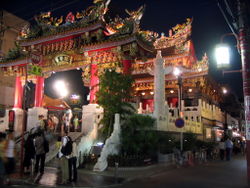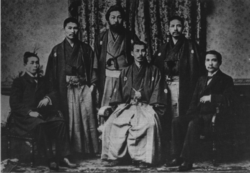- Chinese people in Japan
-
Chinese people in Japan 
Kanteibyou Temple in Yokohama Chinatown Total population 655,377 (as of 2008[update])
0.51% of the Japanese population[1]Regions with significant populations Tokyo, Yokohama, Osaka, and other major cities Languages Related ethnic groups Japanese name Kanji 華僑 Rōmaji Kakyō Literally "Chinese sojourners" Alternate Japanese name Kanji 在日中国人 Rōmaji Zainichi Chūgokujin Literally "Chinese people resident in Japan" Chinese name Traditional Chinese 日本華僑 Simplified Chinese 日本华侨 Hanyu Pinyin Rìběn huáqiáo Chinese people in Japan consist of migrants from China to Japan and their descendants. They have a history going back for centuries.
Contents
Population and distribution
Most Chinese residents in Japan live in major urban areas, such as Tokyo, Yokohama, and Osaka, the latter two of which have a recognised Chinatown as well as schools which use Chinese as the medium of instruction. One 1995 study estimated the Chinese population in Japan to be 150,000, among whom 50,000 to 100,000 spoke Chinese;[2] five years later, Japanese governmental statistics showed 335,575 Chinese residents.[3]
History
Pre-modern era
A Chinese legend of uncertain provenance states that Xu Fu, a Qin Dynasty court sorcerer, was sent by Qin Shi Huang to Penglai Mountain (Mount Fuji) in 219 BC to retrieve an elixir of life. Unwilling to return without the elixir, the myth asserts that Xu instead chose to settle in Japan.[4]
However, Japan's first verifiable Chinese visitor was the Buddhist missionary Hui Shen, whose 499 AD visit to an island east of China known as Fusang, typically identified with modern-day Japan, was described in the 7th-century Liang Shu. Chinese people are also known to have settled in Okinawa during the Sanzan period; the people of the village of Kumemura, for example, are alleged to all be descended from Chinese immigrants.[5]
Modern era
It was estimated that in 1906, more than six thousand Chinese students lived in Japan; many of them resided in Tokyo's Kanda district.[6]
Post-WWII
Post-World War II Chinese immigrants to Japan, typically referred to as shin-kakyō, have come to Japan from both Taiwan and mainland China.
Groups
Foreign students
Many famous Chinese intellectuals have studied in Japan, among them Sun Yat-sen, Lu Xun, and Zhou Enlai.
Workers
The Industrial 'training scheme' used to bring Chinese workers to Japan has been criticized by lawyers as exploitation, after several deaths.[7]
Long-term residents and their descendants
Others
Many Japanese war orphans left behind in China after World War II have migrated to Japan with the assistance of the Japanese government, bringing along their Chinese spouses and children.A
Culture
Cuisine
Chinese restaurants in Japan serve a fairly distinct style of Chinese cuisine. Though in the past Chinese cuisine would have been primarily available in Chinatowns such as those in port cities of Kobe, Nagasaki, or Yokohama, Japanese-style Chinese cuisine is now commonly available all over Japan. As Japanese restaurants are often specialized to offer only one sort of dish, cuisine is focused primarily on dishes found within three distinct types of restaurants: ramen restaurants, dim sum houses, and standard Chinese-style restaurants.
Issues
Ethnic relations
Tokyo governor Shintaro Ishihara has publicly used controversial terms such as sangokujin to refer to Chinese staying illegally in Japan, and implied that they might engage in rioting and looting in the aftermath of a disaster.[8]
Perception
There is a public perception in Japan that many Chinese immigrants come to Japan to engage in criminal activities. Some Chinese workers have entered Japan under false pretenses on cultural visas. As Japanese immigration law does not provide mechanisms for the entry of unskilled workers, and admission under a student visa requires the approval of a recognised university, prospective workers instead apply to study in language schools, which are more lightly regulated. Business owners with a need for low-cost labour have been known to open language schools as fronts for the importation of Chinese workers.[9]
Notable individuals
This is a list of Chinese expatriates in Japan and Japanese citizens of Chinese descent.
Early 20th
- Chen Kenmin, chef regarded as the "father of Sichuan cuisine" in Japan and father of Chen Kenichi
- Go Seigen, professional Go player
- Sun Yat-sen, politician
- Lu Xun, writer
- Qiu Jin, feminist
- Shosei Go, professional baseball player
- Chiang Kai-shek, politician and general
- Song Jiaoren, revolutionary and political figure, founder of Tongmenghui
- Jiang Baili, general
- Guo Moruo, poet and political figure
- He Yingqin, general
- Wang Jingwei, revolutionary and political figure
- Tai Chi-tao, political figure
- Chen Duxiu, co-founder of Chinese Communist Party
- Li Dazhao, co-founder of Chinese Communist Party
- Zhou Zuoren, writer
- Huang Fu, general and politician
- Chen Qimei, revolutionary
Late 20th
- Momofuku Ando, founder of Nissin Foods
- Chen Kenichi, longest-serving participant on Japanese cooking show Iron Chef
- Agnes Chan, pop singer, professor, and writer
- Rissei Ō, professional Go player
- O Meien, professional Go player
- Rin Kaiho, professional Go player
- Cho U, professional Go player
- Chin Shunshin, novelist
21st
- Mo Bangfu, author
- Tsuyoshi Abe, actor (3/4 Chinese, 1/4 Japanese)
- Emi Suzuki, female model (immigrant)
- Wei Son, female model (descendant)
- Qian Lin & Li Chun, singers
- Rola Chen, gravure idol
See also
- Anti-Japanese sentiment in China
- Anti-Chinese sentiment in Japan
- Chinatown
- Chinatowns in Asia
- Kumemura
- Japanese orphans in China
- Japanese people in China
- Ainu people
- Ryukyuans
- Yamato people
References
- ^ "国籍(出身地)別在留資格(在留目的)別外国人登録者(Number of foreign residents by country as of 2008)" (in Japanese). Ministry of Justice. 2009-09-04. http://www.e-stat.go.jp/SG1/estat/Xlsdl.do?sinfid=000004032096.
- ^ Maher, John C. (1995). "The Kakyo: Chinese in Japan". Journal of Multilingual and Multicultural Development v16 (n1–2): p125–138.
- ^ Refsing, Kirsten; Colin MacKerras (ed.) (November 2003). Ethnicity in Asia. United Kingdom: Routledge. pp. 58–59. ISBN 0-415-25816-2.
- ^ CRI Editors (2005-02-18). "Why did Xu Fu go to Japan?". China Radio International. http://en.chinabroadcast.cn/1702/2005-2-18/14@207573.htm. Retrieved 2006-10-25.
- ^ Kerr, George H (2000). Okinawa: the History of an Island People. Boston: Tuttle Publishing. ISBN 0804820872. See page 76.
- ^ Kreiner, Josef; Ulrich Mohwald, Hans-Dieter Olschleger (January 2004). Modern Japanese Society. Brill Academic Publishers. pp. 240–242. ISBN 90-04-10516-6.
- ^ http://search.japantimes.co.jp/cgi-bin/nn20100723a3.html
- ^ Larimer, Tim (2000-04-24). "Rabble Rouser". Time Asia. http://cgi.cnn.com/ASIANOW/time/magazine/2000/0424/cover1.html. Retrieved 2006-10-25.
- ^ Soderberg, Marie; Ian Reader (March 2000). Japanese Influences and Presences in Asia. United Kingdom: Routledge. pp. 242–243. ISBN 0-7007-1110-4.
External links
Overseas Chinese Africa Eastern AfricaEthiopia · Kenya · Madagascar · Mauritius · Mozambique · Réunion1 · Seychelles · Tanzania · Uganda · ZambiaElsewhereAmericas ElsewhereArgentina · Brazil · Canada (from Hong Kong) · Chile · Costa Rica · Mexico · Nicaragua · Panama · Peru · United States (Laotian Chinese)Asia Central AsiaEast AsiaSouth-East AsiaSouth AsiaWest AsiaEurope Bulgaria · Czech Republic · Denmark · France · Germany · Italy · Netherlands · Portugal · Romania · Russia · Serbia · Spain · Turkey · United Kingdom (from Hong Kong)Oceania 1 An overseas department of France in the western Indian Ocean. See also: Hong Kong Diaspora Immigration to Japan Americas Asia Bangladeshis · Burmese · Chinese · Filipinos · Indians · Indonesians · Iranians · Koreans · Mongolians · Nepalis · Pakistanis · Taiwanese · VietnameseOthers See also Dekasegi · Ethnic issues in Japan · Gaijin · Japanese nationality law · Foreign-born Japanese · FushūgakuCategories:- Chinese diaspora
- China–Japan relations
- Japanese people of Chinese descent
- Chinese expatriates in Japan
- Demographics of Japan
- Ethnic groups in Japan
- Ethnic minorities in Japan
- Ethnic issues in Japan
Wikimedia Foundation. 2010.



